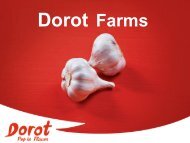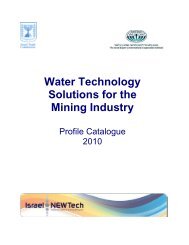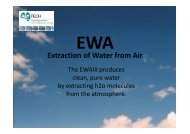PDF file - Israel Trade Commission
PDF file - Israel Trade Commission
PDF file - Israel Trade Commission
Create successful ePaper yourself
Turn your PDF publications into a flip-book with our unique Google optimized e-Paper software.
Agriculture 2011<br />
Figure 2: A very large inlet filter<br />
of the Vardit dripper.<br />
7 8<br />
area and enables water to enter the dripper through one<br />
of the many active inlets (Figure 2). The size of the active<br />
inlet filter is very important for dripper block resistance.<br />
Studies have shown that most of the drippers’ clogs are<br />
found on the inlet filter and that the active area size has<br />
a major impact on dripper clog resistance.<br />
The Assif dripper is an anti -siphon PC dripper designed<br />
mainly for SDI. The anti-siphon mechanism prevents<br />
the suction of surrounding water and dirt into the<br />
dripper, at the end of the irrigation cycle, when the dripline<br />
is drained and vacuum pressure conditions develop<br />
on some areas along the lateral. The Assif dripper is<br />
produced with the Rootguard version for reliable root<br />
protection in SDI.<br />
Figure 1: The Inbar drippers<br />
appear to be almost identical<br />
from the outside.<br />
Figure 3: Partial clogging of the<br />
inlet filter of the Inbar dripper,<br />
when using effluent water, still<br />
enables the nominal dripper<br />
flow-rate.<br />
turbulent, high velocity flow pattern to prevent particles<br />
from settling in the dripper.<br />
Non-drain dripper: a dripper that keeps the lateral filled<br />
with water between irrigation cycles, for immediate<br />
watering from all drippers along the drip-line with each<br />
irrigation cycle.<br />
Anti-siphon dripper: a dripper that shuts down<br />
simultaneously with the drop of pressure in the lateral<br />
at the end of the irrigation cycle, to prevent air and water<br />
suction through the dripper outlet and the penetration<br />
of sand and soil into the dripper - mainly for SDI.<br />
Rootguard dripper: a dripper that contains impregnated<br />
chemicals which prevent root intrusion into the dripper<br />
in SDI, eliminating the need for any other treatment for<br />
many years.<br />
The new Inbar dripper collection was developed by<br />
Metzerplas to meet the challenges of the new generation<br />
of drippers. The group includes three drippers, which<br />
seem almost identical from the outside (Figure 1), but<br />
are distinguished by unique designs to accomplish<br />
special individual features.<br />
The Vardit dripper is a small, flat PC dripper with a very<br />
large inlet filter that covers most of the dripper surface<br />
The Inbar dripper is an ND (Non-Drain) and AS flat PC<br />
dripper that keeps the lateral filled with water between<br />
the irrigation cycles. In a regular drip-line, the lateral is<br />
not filled with water at all times and the first drippers<br />
start to irrigate prior to the adjacent ones. In long<br />
laterals, the time required for a complete filling and<br />
for pressure to be built up can take more than several<br />
minutes. Pulse irrigation, characterized by many short<br />
irrigation cycles during the day, increases the difference<br />
in the watering level of each dripper along the drip-line.<br />
In a ND drip-line, all of the drippers along the lateral<br />
start watering at the same time for better and uniform<br />
water distribution.<br />
The revision of the features of both the ND and the AS<br />
drippers has included a slight reduction in the size of the<br />
inlet filter of the Assif and Inbar models in comparison to<br />
the Vardit dripper, but the active inlet filter has remained<br />
quite large to ensure free water passage into the dripper,<br />
for all water quality levels. Field trials conducted with<br />
Inbar drippers, using secondary treated effluent water<br />
without additional chemical treatment (chlorination or<br />
acidification), have been studied during the past three<br />
years. The results indicate that the drippers maintain<br />
their nominal flow rate, but the inlet filter shows partial<br />
clogging (Figure 3). The inlet filter is large enough and<br />
contains several active holes, each of them capable of<br />
supplying the entire dripper flow-rate, to ensure clog<br />
resistance.<br />
gsagi@zahav.net.il<br />
27
















